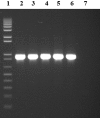F4-related mutation and expression analysis of the aminopeptidase N gene in pigs
- PMID: 24663207
- PMCID: PMC7109699
- DOI: 10.2527/jas.2013-7307
F4-related mutation and expression analysis of the aminopeptidase N gene in pigs
Abstract
Intestinal infections with F4 enterotoxigenic Escherichia coli (ETEC) are worldwide an important cause of diarrhea in neonatal and recently weaned pigs. Adherence of F4 ETEC to the small intestine by binding to specific receptors is mediated by F4 fimbriae. Porcine aminopeptidase N (ANPEP) was recently identified as a new F4 receptor. In this study, 7 coding mutations and 1 mutation in the 3' untranslated region (3' UTR)were identified in ANPEP by reverse transcriptase (RT-) PCR and sequencing using 3 F4 receptor-positive (F4R+) and 2 F4 receptor-negative (F4R-) pigs, which were F4 phenotyped based on the MUC4 TaqMan, oral immunization, and the in vitro villous adhesion assay. Three potential differential mutations (g.2615C > T, g.8214A > G, and g.16875C > G) identified by comparative analysis between the 3 F4R+ and 2 F4R- pigs were genotyped in 41 additional F4 phenotyped pigs. However, none of these 3 mutations could be associated with F4 ETEC susceptibility. In addition, the RT-PCR experiments did not reveal any differential expression or alternative splicing in the small intestine of F4R+ and F4R- pigs. In conclusion, we hypothesize that the difference in F4 binding to ANPEP is due to modifications in its carbohydrate moieties.
Figures

References
-
- Alexander T. J. L. 1994. Neonatal diarrhoea in pigs. In: Gyles C. L. editor, Escherichia coli in domestic animals and humans. Cab International, Wallingford, UK: p. 151–169.
-
- Bakker D., Willemsen P. T., Simons L. H., van Zijderveld F. G., de Graaf F. K. 1992. Characterization of the antigenic and adhesive properties of FaeG, the major subunit of K88 fimbriae. Mol. Microbiol. 6:247–255. - PubMed
Publication types
MeSH terms
Substances
LinkOut - more resources
Full Text Sources
Other Literature Sources
Medical
Miscellaneous

